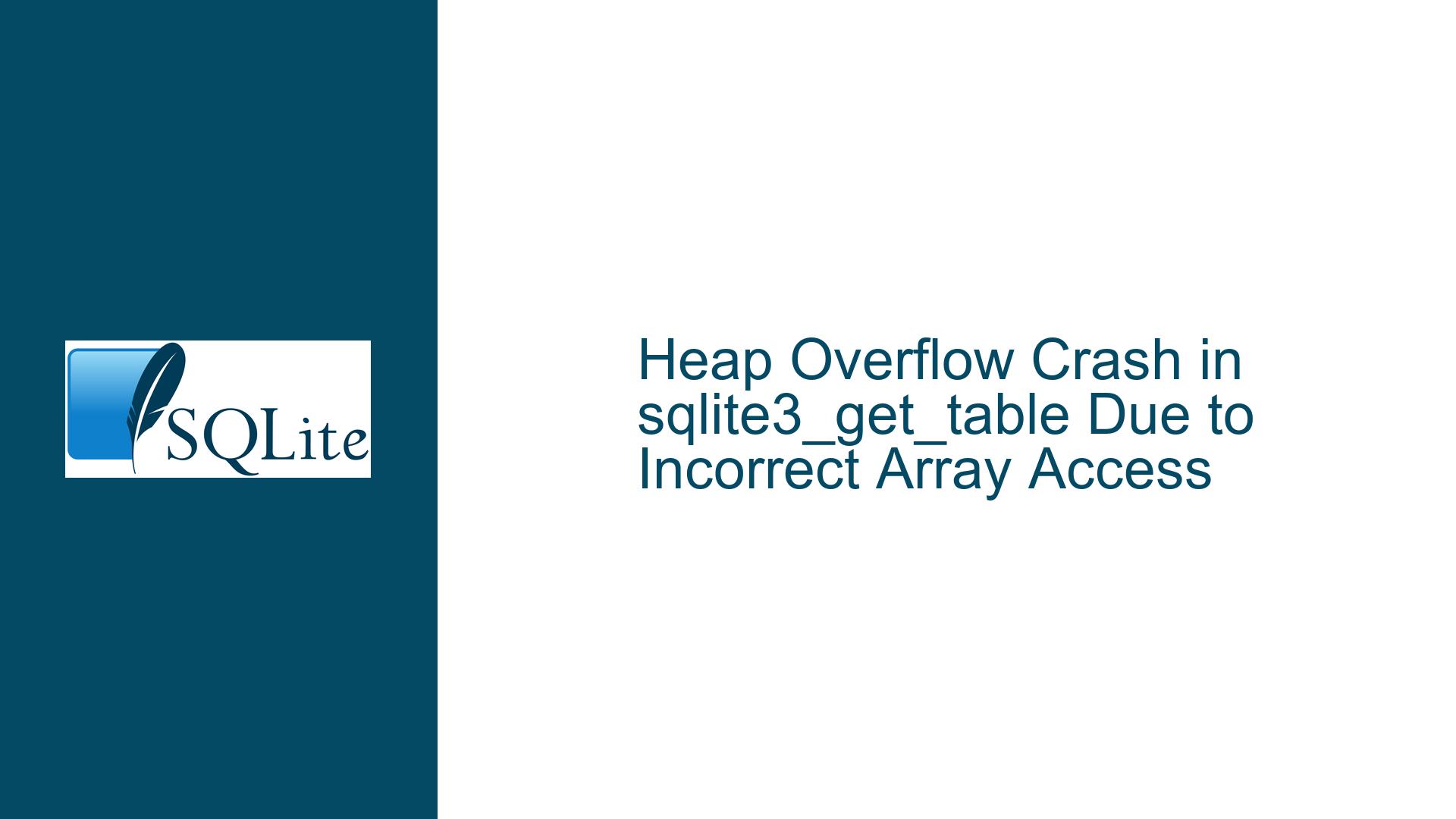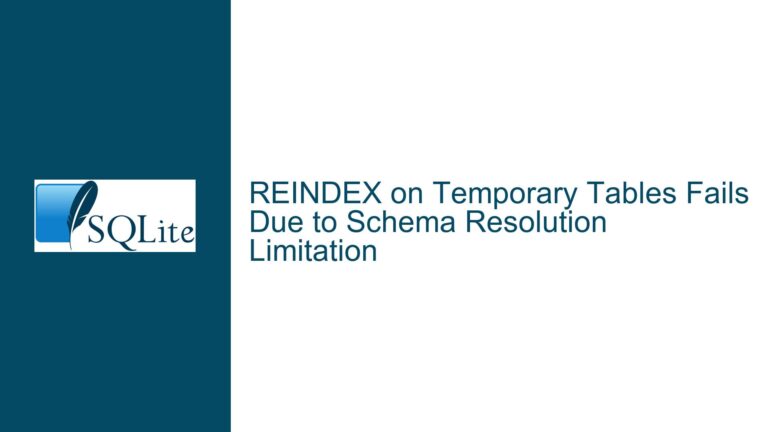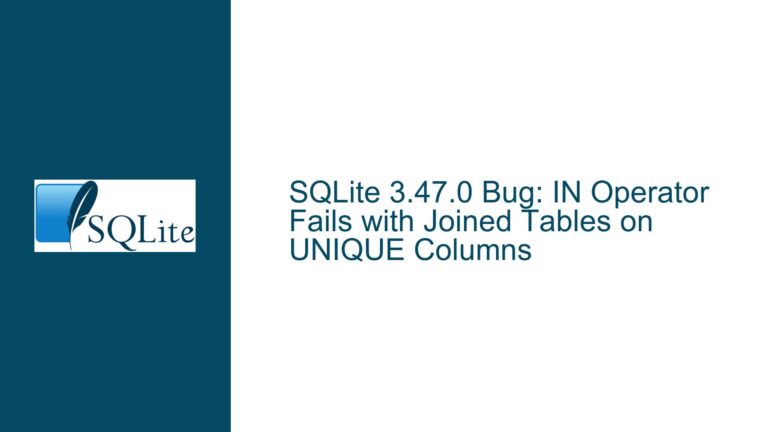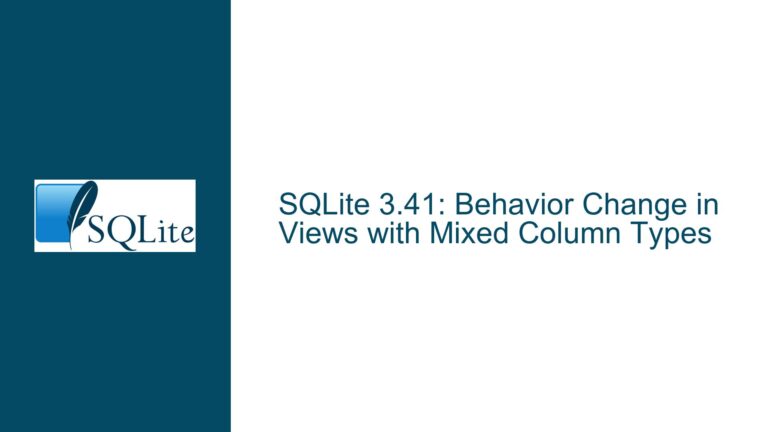Heap Overflow Crash in sqlite3_get_table Due to Incorrect Array Access
Understanding the Heap Overflow Crash in sqlite3_get_table
The issue at hand revolves around a potential heap overflow crash that occurs when using the sqlite3_get_table function in SQLite. This function is designed to retrieve a result set from a query and store it in a dynamically allocated array of strings. The crash manifests when the application attempts to access memory beyond the bounds of the allocated array, leading to undefined behavior, which in this case results in a heap overflow.
The root of the problem lies in the way the sqlite3_get_table function handles memory allocation and the subsequent assignment of the result array to the provided pointer. Specifically, the function initializes two variables, res.nData and res.nAlloc, to 1 and 20 respectively. The res.nData variable represents the number of data entries in the result set, while res.nAlloc represents the allocated size of the array. The function then attempts to reallocate memory for the result array based on the value of res.nData. However, if res.nData is zero, the allocated memory size becomes zero, and any attempt to access the array beyond its bounds will result in a heap overflow.
The crash is triggered when the application tries to access the first entry of the array, which does not exist because the array size is zero. This is a classic example of an out-of-bounds memory access, which can lead to severe consequences, including crashes, data corruption, and even security vulnerabilities.
Possible Causes of the Heap Overflow Crash
The heap overflow crash in sqlite3_get_table can be attributed to several factors, each of which contributes to the overall issue. Understanding these causes is crucial for diagnosing and resolving the problem effectively.
1. Incorrect Initialization of res.nData and res.nAlloc: The sqlite3_get_table function initializes res.nData to 1 and res.nAlloc to 20. However, if the result set contains zero rows or columns, res.nData should ideally be zero. The mismatch between the initialized values and the actual size of the result set leads to incorrect memory allocation, setting the stage for the heap overflow.
2. Improper Memory Reallocation Logic: The function attempts to reallocate memory for the result array based on the value of res.nData. If res.nData is zero, the allocated memory size becomes zero, but the function still assigns the address of the first element of the array to *pazResult. This assignment is problematic because it allows the application to access memory beyond the bounds of the allocated array, leading to a heap overflow.
3. Lack of Bounds Checking: The sqlite3_get_table function does not perform adequate bounds checking before accessing the result array. This lack of validation allows the application to access memory beyond the allocated bounds, resulting in undefined behavior. In this case, the undefined behavior manifests as a heap overflow crash.
4. Misuse of the sqlite3_get_table Function: The application that uses sqlite3_get_table may be misusing the function by not properly handling the case where the result set is empty. If the application assumes that the result array will always contain at least one entry, it may attempt to access the first element without checking the size of the array, leading to a heap overflow.
Troubleshooting Steps, Solutions & Fixes
Resolving the heap overflow crash in sqlite3_get_table requires a thorough understanding of the function’s behavior and the underlying causes of the issue. The following steps outline a comprehensive approach to diagnosing and fixing the problem.
1. Validate the Result Set Size: Before accessing the result array, the application should validate the size of the result set. If the result set is empty (i.e., res.nData is zero), the application should handle this case appropriately, such as by returning an error or skipping the access to the result array. This validation step ensures that the application does not attempt to access memory beyond the bounds of the allocated array.
2. Correct Memory Allocation Logic: The memory allocation logic in sqlite3_get_table should be modified to handle the case where res.nData is zero. Instead of allocating memory based on res.nData, the function should allocate memory based on the actual size of the result set. If the result set is empty, the function should allocate a minimal amount of memory (e.g., one element) to avoid accessing memory beyond the bounds of the array.
3. Implement Bounds Checking: The sqlite3_get_table function should implement bounds checking before accessing the result array. This check ensures that the application does not attempt to access memory beyond the allocated bounds. If the bounds check fails, the function should return an error or handle the situation gracefully to prevent a heap overflow.
4. Update Application Logic: The application that uses sqlite3_get_table should be updated to handle the case where the result set is empty. This update involves checking the size of the result array before accessing its elements. If the result array is empty, the application should handle this case appropriately, such as by displaying a message to the user or skipping the operation that requires the result set.
5. Use Alternative Functions: If the application requires more robust handling of result sets, consider using alternative functions provided by SQLite, such as sqlite3_prepare_v2, sqlite3_step, and sqlite3_column_text. These functions provide more control over the result set and allow the application to handle empty result sets more gracefully.
6. Test with Edge Cases: To ensure that the fixes are effective, the application should be tested with edge cases, such as queries that return empty result sets. This testing helps identify any remaining issues and ensures that the application handles all possible scenarios correctly.
7. Review Documentation and Best Practices: Review the SQLite documentation and best practices for using sqlite3_get_table and related functions. The documentation provides valuable insights into the correct usage of these functions and highlights potential pitfalls to avoid.
8. Monitor for Future Issues: After implementing the fixes, monitor the application for any future issues related to memory access and result set handling. This monitoring helps identify any remaining vulnerabilities and ensures that the application remains stable and secure.
By following these troubleshooting steps and implementing the suggested solutions, the heap overflow crash in sqlite3_get_table can be effectively resolved. The key is to understand the underlying causes of the issue and address them systematically to ensure the stability and security of the application.






